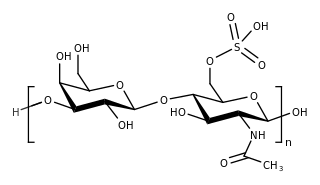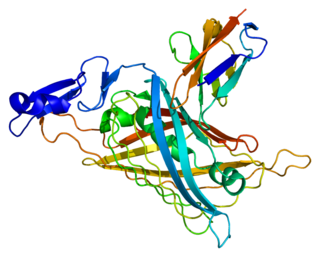Related Research Articles

In biology, the extracellular matrix (ECM) is a three-dimensional network consisting of extracellular macromolecules and minerals, such as collagen, enzymes, glycoproteins and hydroxyapatite that provide structural and biochemical support to surrounding cells. Because multicellularity evolved independently in different multicellular lineages, the composition of ECM varies between multicellular structures; however, cell adhesion, cell-to-cell communication and differentiation are common functions of the ECM.

Oligodendrocytes, or oligodendroglia, are a type of neuroglia whose main functions are to provide support and insulation to axons in the central nervous system of some vertebrates, equivalent to the function performed by Schwann cells in the peripheral nervous system. Oligodendrocytes do this by creating the myelin sheath. A single oligodendrocyte can extend its processes to 50 axons, wrapping approximately 1 μm of myelin sheath around each axon; Schwann cells, on the other hand, can wrap around only one axon. Each oligodendrocyte forms one segment of myelin for several adjacent axons.

Chondrocytes are the only cells found in healthy cartilage. They produce and maintain the cartilaginous matrix, which consists mainly of collagen and proteoglycans. Although the word chondroblast is commonly used to describe an immature chondrocyte, the term is imprecise, since the progenitor of chondrocytes can differentiate into various cell types, including osteoblasts.

Oligodendrocyte progenitor cells (OPCs), also known as oligodendrocyte precursor cells, NG2-glia or polydendrocytes, are a subtype of glial cells in the central nervous system. They are process-bearing glial cells (neuroglia) in the mammalian central nervous system (CNS) that are identified by the expression of the NG2 chondroitin sulfate proteoglycan (CSPG4) and the alpha receptor for platelet-derived growth factor (PDGFRA). They are precursors to oligodendrocytes and may also be able to differentiate into neurons and astrocytes.

Versican is a large extracellular matrix proteoglycan that is present in a variety of human tissues. It is encoded by the VCAN gene.

Keratan sulfate (KS), also called keratosulfate, is any of several sulfated glycosaminoglycans that have been found especially in the cornea, cartilage, and bone. It is also synthesized in the central nervous system where it participates both in development and in the glial scar formation following an injury. Keratan sulfates are large, highly hydrated molecules which in joints can act as a cushion to absorb mechanical shock.

Perlecan (PLC) also known as basement membrane-specific heparan sulfate proteoglycan core protein (HSPG) or heparan sulfate proteoglycan 2 (HSPG2), is a protein that in humans is encoded by the HSPG2 gene.

Aggrecan (ACAN), also known as cartilage-specific proteoglycan core protein (CSPCP) or chondroitin sulfate proteoglycan 1, is a protein that in humans is encoded by the ACAN gene. This gene is a member of the lectican family. The encoded protein is an integral part of the extracellular matrix in cartilagenous tissue and it withstands compression in cartilage.
Neuroregeneration refers to the regrowth or repair of nervous tissues, cells or cell products. Such mechanisms may include generation of new neurons, glia, axons, myelin, or synapses. Neuroregeneration differs between the peripheral nervous system (PNS) and the central nervous system (CNS) by the functional mechanisms involved, especially in the extent and speed of repair. When an axon is damaged, the distal segment undergoes Wallerian degeneration, losing its myelin sheath. The proximal segment can either die by apoptosis or undergo the chromatolytic reaction, which is an attempt at repair. In the CNS, synaptic stripping occurs as glial foot processes invade the dead synapse.

Syndecan 1 is a protein which in humans is encoded by the SDC1 gene. The protein is a transmembrane heparan sulfate proteoglycan and is a member of the syndecan proteoglycan family. The syndecan-1 protein functions as an integral membrane protein and participates in cell proliferation, cell migration and cell-matrix interactions via its receptor for extracellular matrix proteins. Syndecan-1 is a sponge for growth factors and chemokines, with binding largely via heparan sulfate chains. The syndecans mediate cell binding, cell signaling, and cytoskeletal organization and syndecan receptors are required for internalization of the HIV-1 tat protein.
Chondroitinase treatment is a treatment of proteoglycans, a protein in the fluid among cells where they affect neural activity. Chondroitinase treatment has been shown to allow adults vision to be restored as far as ocular dominance is concerned. Moreover, there is some evidence that Chondroitinase could be used for the treatment of spinal injuries.

Glial scar formation (gliosis) is a reactive cellular process involving astrogliosis that occurs after injury to the central nervous system. As with scarring in other organs and tissues, the glial scar is the body's mechanism to protect and begin the healing process in the nervous system.

Perineuronal nets (PNNs) are specialized extracellular matrix structures responsible for synaptic stabilization in the adult brain. PNNs are found around certain neuron cell bodies and proximal neurites in the central nervous system. PNNs play a critical role in the closure of the childhood critical period, and their digestion can cause restored critical period-like synaptic plasticity in the adult brain. They are largely negatively charged and composed of chondroitin sulfate proteoglycans, molecules that play a key role in development and plasticity during postnatal development and in the adult.

Collagen alpha-2(VI) chain is a protein that in humans is encoded by the COL6A2 gene.

Chondroitin sulfate proteoglycan 4, also known as melanoma-associated chondroitin sulfate proteoglycan (MCSP) or neuron-glial antigen 2 (NG2), is a chondroitin sulfate proteoglycan that in humans is encoded by the CSPG4 gene.

Neurocan core protein is a protein that in humans is encoded by the NCAN gene.

Chondroitin sulfate proteoglycan 5 is a protein that in humans is encoded by the CSPG5 gene.
Angiogenesis is the process of forming new blood vessels from existing blood vessels. It is a highly complex process involving extensive interplay between cells, soluble factors, and the extracellular matrix (ECM). Angiogenesis is critical during normal physiological development, but it also occurs in adults during inflammation, wound healing, ischemia, and in pathological conditions such as rheumatoid arthritis, hemangioma, and tumor growth. Proteolysis has been indicated as one of the first and most sustained activities involved in the formation of new blood vessels. Numerous proteases including matrix metalloproteases (MMPs), a disintegrin and metalloprotease domain (ADAM), a disintegrin and metalloprotease domain with throbospondin motifs (ADAMTS), and cysteine and serine proteases are involved in angiogenesis. This article focuses on the important and diverse roles that these proteases play in the regulation of angiogenesis.

Chondroitin sulfate proteoglycans (CSPGs) are proteoglycans consisting of a protein core and a chondroitin sulfate side chain. They are known to be structural components of a variety of human tissues, including cartilage, and also play key roles in neural development and glial scar formation. They are known to be involved in certain cell processes, such as cell adhesion, cell growth, receptor binding, cell migration, and interaction with other extracellular matrix constituents. They are also known to interact with laminin, fibronectin, tenascin, and collagen. CSPGs are generally secreted from cells.

Carbohydrate sulfotransferases are sulfotransferase enzymes that transfer sulfate to carbohydrate groups in glycoproteins and glycolipids. Carbohydrates are used by cells for a wide range of functions from structural purposes to extracellular communication. Carbohydrates are suitable for such a wide variety of functions due to the diversity in structure generated from monosaccharide composition, glycosidic linkage positions, chain branching, and covalent modification. Possible covalent modifications include acetylation, methylation, phosphorylation, and sulfation. Sulfation, performed by carbohydrate sulfotransferases, generates carbohydrate sulfate esters. These sulfate esters are only located extracellularly, whether through excretion into the extracellular matrix (ECM) or by presentation on the cell surface. As extracellular compounds, sulfated carbohydrates are mediators of intercellular communication, cellular adhesion, and ECM maintenance.
References
- 1 2 Nishiyama A, Dahlin KJ, Prince JT, Johnstone SR, Stallcup WB. "The primary structure of NG2: a novel membrane-spanning proteoglycan." J Cell Biol. 1991 Jul;114(2):359-71. PMID 1906475.
- 1 2 Asher RA, Morgenstern DA, Fawcett JW. "Chondroitin sulphate proteoglycans: inhibitory components of the glial scar." Prog Brain Res. 2001;132:611-9. PMID 11545024.
- 1 2 Nishiyama A, Lin ZH, Stallcup WB. "Generation of truncated forms of the NG2 proteoglycan by cell surface proteolysis." Mol Biol Cell. 1995 Dec;6(12):1819-32. PMID 8590808
- 1 2 Ozerdem U, Grako KA, Dahlin-Huppe K, Monosov E, Stallcup WB. "NG2 proteoglycan is expressed exclusively by mural cells during vascular morphogenesis." Dev. Dyn. (2001 Oct) 222(2):218 – 227. PMID 11668599
- 1 2 Al-Mayhani MT, Grenfell R, Narita M, Piccirillo S, Kenney-Herbert E, Fawcett JW, Collins VP, Ichimura K, Watts C. "NG2 expression in glioblastoma identifies an actively proliferating population with an aggressive molecular signature." Neuro Oncol. 2001 Aug; 13(8):830-45. PMID 21798846
- 1 2 Girolamo F, Dallatomasina A, Rizzi M, Errede M, Walchli T, Mucignat MT, Frei K, Roncali L, Perris R, and Virgintino D. "Diversified expression of NG2/CSPG4 isoforms in glioblastoma and human foetal brain identifies pericytes subsets." PLoS One. 2013 Dec 26;8(12):e84883. PMID 24386429.
- 1 2 Poli A, Wang J, Domingues O, Planaguma J, Yan T, Rygh CB, Skaftnesmo KO, Thorsen F, McCormack E, Hentges F, Pedersen PH, Zimmer J, Enger PO, Chekenya M. "Targeting glioblastoma with NK cells and mAb against MG2/CSPG4 prolongs animal survival." Oncotarget. 2013 Sep;4(9):1527-46. PMID 24127551
- 1 2 Levine JM, Reynolds R, Fawcett JW. "The oligodendrocyte precursor cell in health and disease." Trends Neurosci. 2001 Jan;24(1):39-47. PMID 11163886.
- 1 2 Stallcup WB. "The NG2 proteoglycan: past insights and future prospects." J. Neurocytol. 2002 Jul-Aug;31(6-7):423-35. PMID 14501214
- 1 2 Levine JM, Nishiyama A. "The NG2 chondroitin sulfate proteoglycan: a multifunctional proteoglycan associated with immature cells." Perspect Dev Neurobiol. 1996;3(4):245-59. PMID 9117258
- ↑ Castro et al. (2020) Specific labeling of synaptic Schwann cells reveals unique cellular and molecular features. 2020;9:e56935 DOI:10.7554/eLife.56935. PMID 32584256
- ↑ Jones LL, Yamaguchi Y, Stallcup WB, Tuszynski MH. "NG2 is a major chondroitin sulfate proteoglycan produced after spinal cord injury and is expressed by macrophages and oligodendrocyte progenitors." J Neurosci. 2002 Apr 1;22(7):2792-803. PMID 11923444
- ↑ Levine JM. "Increased expression of the NG2 chondroitin-sulfate proteoglycan after brain injury." J. Neurosci. 1994 Aug;14(8):4716-30. PMID 8046446
- ↑ Zhang Y, Tohyama K, Winterbottom JK, Haque NS, Schachner M, Lieberman AR, Anderson PN. "Correlation between putative inhibitory molecules at the dorsal root entry zone and failure of dorsal root axonal regeneration." Mol Cell Neurosci. 2001 Mar;17(3):444-59. PMID 11273641.
- ↑ Tillet et al. 1997, Goretzki et al. 1999